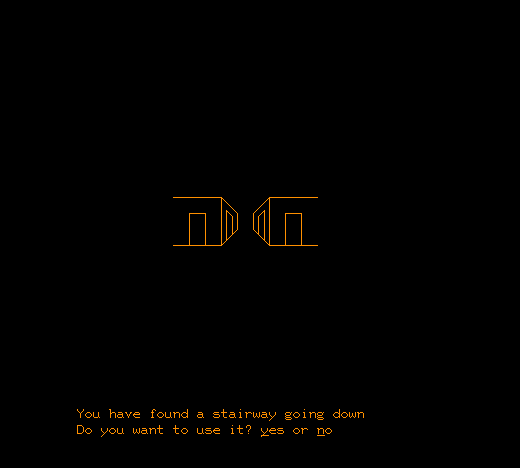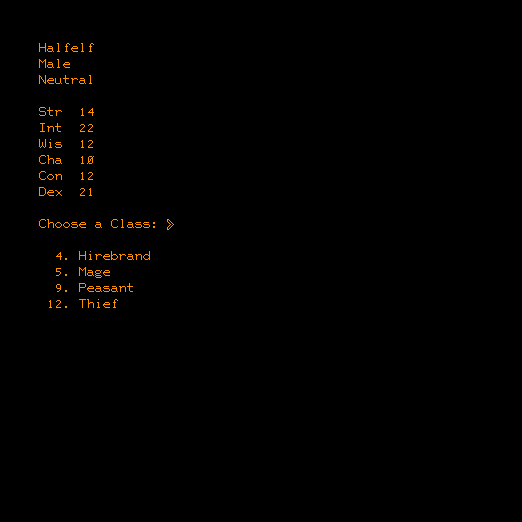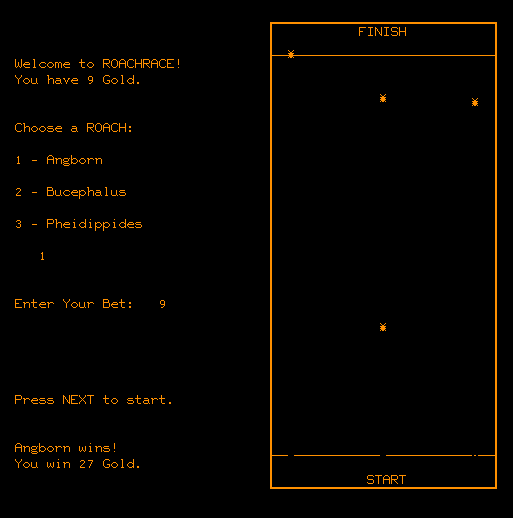From CRPG Adventures
After far too long, I’m starting another game for the blog. That doesn’t mean that I’m done with Moria. Far from it; I’ll still be plugging away at that monstrosity in the background, but there’s little more that I can say about it. It’ll get another post once I’m finished with it, and in the mean-time I’ll be pushing ahead and playing more games from 1977 and 1978.
There’s always a sense of excitement that comes with starting a new game, but this time around it’s mixed with quite a bit of trepidation. Oubliette is another PLATO RPG, and as readers of the blog will know the last few of those have consumed my life. I really don’t want to get bogged down in another one, and I really don’t want to be bogged down in two at the same time. The good news is that Oubliette is nowhere near as large as Moria. (At 240-odd large dungeon levels, few games are.)
 |
|
| Castles seem to be the standard thing to put on your PLATO title screen |
Oubliette was created primarily by Jim Schwaiger, and released on PLATO in November 1977. Like most PLATO games it was in continuous development for a number of years, with changes being made to it up through 1982. I have no idea what differences there might be between the game as it was in 1977, and the 1982 version. Presumably the one on cyber1 – which is the one I’m playing – is the version from 1982. The game was later released on home computers, and even on iphone (as the title screen above indicates). I’ll cover the home computer release when I get to it in the timeline, but needless to say I’ll probably never get to the iphone version.
Oubliette is a dungeon exploration game that is viewed from a first-person perspective. The game is intended for multiple players, who each control a single character and interact within a shared environment. It can be played as a single-player game, but survival is difficult, and the intention is that characters will band together to form parties before braving the depths. As far as I can tell, there’s no goal to be achieved in Oubliette: characters simply band together to explore the dungeon for treasure, and presumably the multiplayer interaction and competition was incentive enough to keep people interested. It’s a relief, to be honest; I can drop this game at any time without feeling like I’ve missed something.
 |
| Beginning the game, with my character standing on the stairs to the dungeon. |
Character creation is more complex than anything that’s been seen to this point. The first step is to choose from one of 15 races. The standard D&D races are there, along with some from Tolkien (Uruk-Hai, Eldar), some monsters (Ogre, Pixie, Goblin, Hobgoblin, Kobold), and one pulled from Stephen Donaldson’s Thomas Covenant series (Ur-Vile), which is surprising considering that the first book of that series had only been released a year prior.
Following that your attributes are determined, and they’re the standard six from Dungeons & Dragons: Strength, Intelligence, Wisdom, Charisma, Constitution, and Dexterity. The race you chose earlier determines the range for each of these attributes. Your gender is also randomly determined here, which seems an odd thing to leave to chance. You can reroll as many times as you like until you get a character that you like.
Once you’ve accepted your attributes, you choose an Alignment from one of three: Lawful, Neutral or Chaotic. Some races will have restrictions here (for example, I created an Orc character that could not choose Lawful). I’m not sure what effect this has on the game at this point, except to affect what class you can choose in the next step.
Choosing a class comes next, and there are fifteen in the game: cleric, demondim (another one from Thomas Covenant), courtesan, hirebrand, mage, minstrel, ninja, paladin, peasant, ranger, raver (Covenant again), thief, sage, samurai, and valkyrie. The classes available to you are determined by race, class, and alignment. The unusual classes are harder to qualify for, whereas pretty much anyone can be a peasant.
 |
| Creating a character. Even with good stats like these, I only have a few classes to choose from. |
Once a class is chosen, you get the option of starting in the castle or the dungeon. I always opt for the castle, and I’m not sure why you’d choose differently; starting in the dungeon with no gear or followers is basically suicide.
LIGNE Castle is the hub of the game, where characters can stock up on supplies, form parties, and do all sorts of other cool stuff. It’s big – 29×29 squares – and there are tons of things to do. I’ll hit some highlights below:
- There’s a separate guild for every class, and you need to join one in order to level up. You can increase your guild rank by making donations, but there’s no indication of how much is needed. I donated about 1,000 gold pieces with my first character, and my rank was still 0. Once you have a ranking of 1 you can hire a companion that will follow you free of charge, but should that companion die your rank drops by one.
- There are shops where you can buy charmed monsters, ranging from lowly kobolds right up to Orcus himself. There’s even a shop where you can get these monsters for free, though I suspect that there’s a catch with this that I haven’t twigged to yet. These monsters stay with you until you rest, but you can get around that by selling them back to the shop then buying them back later on.
 |
| Obtaining a charmed monster for free. |
- Hotels where you can rest and recover lost hit points. You can rest anywhere in the castle, but it’s quicker to do so in a hotel (and I’m pretty sure that character’s age in this game, so time is a factor).
- Taverns, which are the place where you go to join up with other adventurers and form parties. (Because even this far back, it was understood that all adventures begin in a tavern.)
- Corwin’s General Store, where you buy weapons, armour, torches and holy water. Torches are valuable, because you need them to see in the dungeon unless you choose a race that can see in the dark. This is the main reason that I chose a dwarf as my initial character.
- Merlin’s Magic Shoppe, where you can buy and sell magic items. Items to buy are listed by category. You type in the category you want, and you get a list of available items with nothing to differentiate them but price. What you’re buying is a mystery; presumably the more expensive the better, but I haven’t bought anything yet so it’s impossible to say.
- There’s a Jail where you can look for character’s by name. It’s not clear how you end up in jail, or what you can do should you find the character you’re looking for.
- Hidden in an out-of-the-way spot is the Patriarch’s Temple, but said Patriarch will only see you if you make a donation. According to the documentation he can help identify magic items, but I haven’t tested this out yet (nor have I actually found any magic items).
- The Morgue is another place where you can search for character’s by name. I understand that you can find the corpses of dead characters in the dungeon and return them to the city; this is probably where they go if you don’t have the gold or the desire to resurrect them.
- You can visit Kesim’s Casino and gamble on blackjack, craps or cockroach racing. These Are the first gambling mini-games in CRPGs to my knowledge, and the cockroach racing is delightfully odd. It’s a good place to build up your gold before buying weapons, I’ve found.
 |
| Winning money on the roaches. |
- Brand’s Potion Shop, where you can buy various potions and scrolls. When your basic healing potion costs around 70,000gp, though, the prices are probably too high.
- Honest John’s Bank and Trust. I haven’t done anything here yet, but I can only assume that you can deposit and withdraw gold here. (I can’t check right now, because cyber1 is down for backups.) I need to come back here to check if I’m able to rob the bank.
- Ghenghis’ Army Recruiter, which is a mystery. There’s a sign that says it’s closed due to budget cuts, and there’s nothing else that can be done here.
With the city mapped, monster companion recruited (a pyrohydra), and armaments purchased, it was time for me to take Axebeard the Dwarf into the dungeon. I did quite well for a while, surviving a number of battles and forays. The monsters that I encountered were the usual array of low-level D&D types: rats, goblins, kobolds, etc, in groups of about 6. My character gained about 3,000 experience points, but I couldn’t figure out how to level up, or even if I had enough xp to do so. It’s supposed to be done at the guild, but the option never appeared for me.
In the end, I was killed by a band of 7 kobolds. It happened very suddenly: one second I was at full hit points, the next I was dead. Combat was a little hard to fathom. The word ‘Options’ appears under the name of the enemy, and you have a limited time to input your command (F for fight, in most cases). A message would come up telling me if I killed an enemy (and if my charmed monster did so), then a message would flash telling me what the monsters did. That message was very quick, and I never did get a good look at what it said. At the moment, the combat workings are a bit of a mystery to me.
 |
| Deciding whether to delete my character or wait for someone else to retrieve his body. Odds seem slim for the latter in 2017. |
The influences here are strong, and obvious. The first is, of course, Dungeons & Dragons. More specifically, the original pre-AD&D version of the game. The monster list makes it obvious that they’re working from the AD&D Monster Manual, but there are enough references and bits of terminology that I’m confident in saying that the rest of Oubliette is based on the original D&D rules. More than any other game previous, this game emulates D&D, right down to the way that early campaigns were played. The first D&D campaigns were run by a single referee in a single, huge dungeon, with a rotating pool of players that all explored the same location. Oubliette emulates that exactly, and copies over a lot of the rules and monsters as well. The main deviation is in the number of races and classes, but I wouldn’t be at all surprised if Jim Schwaiger and his players had homebrewed all of the new types for their own campaign. It’s how things were done in those days.
The other influence is Moria, which was also a first-person dungeon exploration game where you could join up with other characters. It had a large city, shops with loads of stuff to buy, guilds, characters that age, and a bunch of other similarities to Oubliette. As far as I can tell, Oubliette takes those ideas and expands on them, providing a more varied and interesting game experience.That’s my first impression, anyway; we’ll see if it holds up.
I’m not setting myself any goals for Oubliette just yet; I’ve learned my lesson with Moria. There aren’t any goals I can set really; the game itself doesn’t provide any. It will all depend on how difficult it is. If I find that I can survive on my own, I’ll try to map out the 10-level dungeon. If it proves to be too deadly, I’ll play it for a few weeks and then move on.
Original URL: http://crpgadventures.blogspot.com/2017/02/oubliette-1977.html
